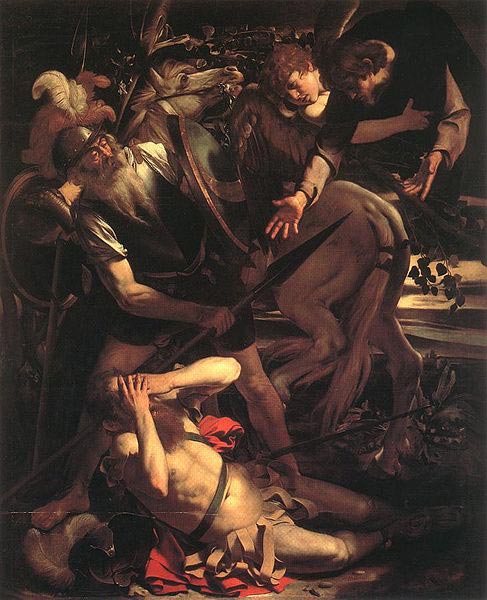| Conversion of St. Paul | |
|---|---|
 |
|
| Artist | Caravaggio |
| Year | 1600/1601 |
| Medium | Oil on cypress wood |
| Location | Odescalchi Balbi Collection, Rome |
| Dimensions | 93 in × 74 in |
| 237 cm × 189 cm | |
| Famous Paintings by Caravaggio | |
| David with the Head of Goliath | |
| Medusa | |
| Bacchus | |
| Conversion of St. Paul | |
| Ecce Homo | |
| Narcissus | |
| Judith Beheading Holofernes | |
| Supper At Emmaus | |
| Sacrifice of Isaac | |
| Complete Works |
Caravaggio visits the theme of St. Paul’s conversion on the way to Damascus at least twice. The one most people are familiar with is the one that’s dominated almost entirely by the stricken saint’s horse. That one is in the Cerasi Chapel of the Church of Santa Maria del Popolo. The other one, which is really called The Conversion of Saint Paul, is now part of the Odescalchi Balbi Collection in Rome.
Created between 1600 and 1601, this conversion, like the Cerasi Chapel painting, uses Caravaggio’s trademark light and dark or chiaroscuro technique to depict a busy, historical and event.
Falling
In this version, the man then known as Saul is depicted as a middle aged and rather pudgy man. He’s not only been knocked off his horse from the brilliant light, but he’s been knocked out of much of his soldierly attire. His plumed helmet is on the ground and only a Roman pteruges preserves his modesty. He is, if the viewer looks, actually half way to hitting the ground, and his mantle, which Caravaggio paints a dramatic red, is unraveling. The light that bathes his torso is bright, but not overly so. Still the saint shields his eyes and cries out both from the pain of the light that’s just struck them and from being so rudely knocked off his horse. Unlike the horse in the Cerasi Chapel painting, this one is understandably spooked.
Hearing (and Not Hearing) the Voice of God
Also, Saul’s fellow soldier, an older but still well-muscled man, rises to his defense. In one hand he clutches a spear and in the other he raises his shield. Interestingly, this soldier doesn’t quite understand what he’s defending Saul against, for though Saul’s companions did see the light, they didn’t hear the voice of God that accompanied it.
It’s also telling that the spear, a wicked looking weapon whose danger we understand even though it’s half in shadow, is pointed right at the figure of Jesus, who the soldier can’t even see. In turn, Jesus, supported by an angel, reaches down from heaven to inquire, “Why do you persecute me?”